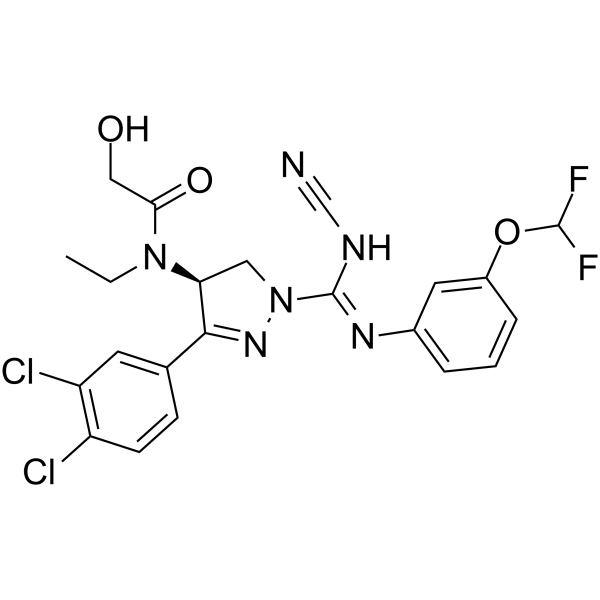| Cas No.: | 1906919-67-2 |
| Chemical Name: | 1906919-67-2 (S-Isomer) |
| Synonyms: | BAY-598;(S,E)-N-(1-(N'-cyano-N-(3-(difluoromethoxy)phenyl)carbamimidoyl)-3-(3,4-dichlorophenyl)-4,5-dihydro-1H-pyrazol-4-yl)-N-ethyl-2-hydroxyacetamide;BAY 598 - Bio-X;BAY598;GTPL8953;BAY 598;BDBM50180955;J3.601.000B;Q27074893;(S)-N-(1-(N'-Cyano-N-(3-(difluoromethoxy)phenyl)carbamimidoyl)-3-(3,4-dichlorophenyl)-4,5-dihydro-1H-pyrazol-4-yl)-N-ethyl-2-hydroxyacetamide;(S,Z)-N-(1-(N-cyano;1906919-67-2 (S-Isomer) |
| SMILES: | ClC1=C(C([H])=C([H])C(=C1[H])C1[C@]([H])(C([H])([H])N(/C(=N/C2C([H])=C([H])C([H])=C(C=2[H])OC([H])(F)F)/N([H])C#N)N=1)N(C(C([H])([H])O[H])=O)C([H])([H])C([H])([H])[H])Cl |
| Formula: | C22H20Cl2F2N6O3 |
| M.Wt: | 525.3354 |
| Purity: | >98% |
| Sotrage: | 2 years -20°C Powder, 2 weeks 4°C in DMSO, 6 months -80°C in DMSO |
| Description: | BAY-598 is selective small molecule inhibitor of SMYD2 . |
| In Vitro: | BAY-598 treatment blocks in vitro methylation of MAPKAPK3 by SMYD2 but has no activity against the SMYD2-related KMT SMYD3. BAY-598 treatment reduces the growth of Kras;p53 mutant PDAC cells after 9 d in culture but has little impact on the growth of Kras;p53;Smyd2 mutant cells[1]. |
| Kinase Assay: | For SMYD2 inhibition, 10 µL of BAY-598 or DMSO is first incubated with recombinant SMYD2 in methylation buffer reaction for 1 h at 30°C, and then 2 µCi of 3H-AdoMet is added to the mix and incubated overnight at 30°C. The reaction mixture is resolved by SDS-PAGE followed by autoradiography, Coomassie stain, or MS analysis[1]. |
| Cell Assay: | Cells are seeded in 96-well plates at 2000 cells per well (optimum density for growth) in a total volume of 100 μL of medium containing 2% fetal bovine serum. Serially diluted BAY-598 in 100 μL of medium is added to the cells 12 h later. After 72 h of incubation, cell viability is assessed by an MTT assay according to the manufacturer's instructions[1]. |
| References: | [1]. Reynoird N, et al. Coordination of stress signals by the lysine methyltransferase SMYD2 promotes pancreaticcancer. Genes Dev. 2016 Apr 1;30(7):772-85. |

 To enhance service speed and avoid tariff delays, we've opened a US warehouse. All US orders ship directly from our US facility.
To enhance service speed and avoid tariff delays, we've opened a US warehouse. All US orders ship directly from our US facility.




















